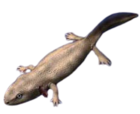| Geotrypetes | |
|---|---|
 | |
| Geotrypetes seraphini | |
| Scientific classification | |
| Domain: | Eukaryota |
| Kingdom: | Animalia |
| Phylum: | Chordata |
| Class: | Amphibia |
| Order: | Gymnophiona |
| Clade: | Apoda |
| Family: | Dermophiidae |
| Genus: | Geotrypetes Peters, 1880 |
| Species | |
3 species (see text) | |
Geotrypetes is a genus of caecilians in the family Dermophiidae, [1] [2] although some classifications place it in the family Caeciliidae. [3] They occur in tropical West Africa and are sometimes known as the West African caecilians. [1]




